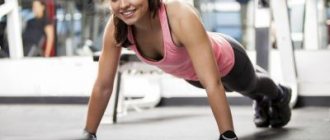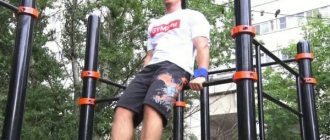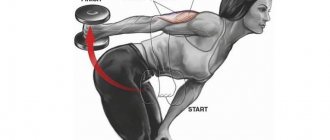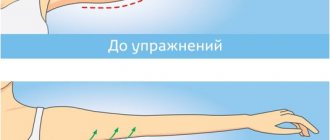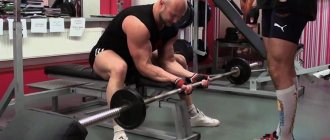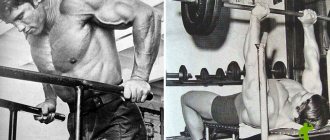The simple push-up is the best basic exercise that can benefit any athlete from any sport. You can do them anywhere, without using any projectiles. “You will always have a floor,” said Steve House, creator of the alpine athletics training program. Push-ups work the chest, shoulders and triceps, as well as the torso, legs and back. This is a lot for such a simple exercise, but if you have the wrong technique, then the benefits of the exercises are greatly reduced.
To learn how to do push-ups correctly, you need to master the correct plank. Your arms should be fully extended, with your arms, elbows and shoulders in a straight line. There should be no more than 30 cm between your feet, and the closer they are to each other, the more difficult the push-ups are because you need more core stability. As the exercise progresses (unless variation changes it), your spine should be neutral so that your body forms a straight line from your heels to your head. Remember to engage your core and hip muscles to keep your hips in that straight line.
You can bend your elbows at right angles to create a T shape, which tightens your pectoral muscles, or you can tuck your elbows toward your sides to put more pressure on your triceps, says Jared Wagy, doctor of physical therapy and a certified strength training specialist. You need to lift your entire body and excess weight will hinder you. For functional movement, you're unlikely to need pumped pecs, but triceps are useful in life - think skiing, maintaining balance when walking on uneven ground, or rock climbing. Elbows are also a fairly sensitive part of the body, especially in people with weak joints, so toned muscles can take on some of the work.
To prevent shoulder injury, Vagi advises you to lower your chest just below the line between your bent elbows so that your forearms are parallel to the ground. If you go lower, the shoulder joint will experience extra stress.
Regarding speed, there is no reason to perform this exercise quickly. Proper technique is much more important than speed. Always move slowly and in a controlled manner. Make this exercise meditative, focus on breathing: inhale as you lower and exhale as you push off the floor.
Advantages and disadvantages
Benefits of push-ups
- Multi-joint exercise , which allows you to work several muscle groups without additional weights, with your own weight.
- The exercise can be performed anywhere - the gym or at home, and does not require much time and space.
- There are practically no contraindications to performing the exercise and it can be performed at any age. Only with spinal problems is it necessary to control the deflection of the lower back and keep your back straight so as not to aggravate the problem.
- You can do push-ups with any level of physical fitness , from beginner to experienced athlete, depending on the type of exercise chosen.
Flaws
- The exercise is not suitable for gaining muscle mass, since its complexity will not allow you to get the proper load with a small number of repetitions, with the exception of the option of push-ups with weights.
- At first, not everyone can do push-ups with their own weight on the floor; for this it is necessary to prepare the body and strengthen the muscles with preparatory exercises.
Basic mistakes when doing push-ups
Push-ups are not as simple an exercise as it seems at first glance. Errors in technique are made not only by practitioners, but even by coaches! Improperly performing push-ups can lead to injuries to the wrists, shoulder and elbow joints, as well as pain in the neck, back and lower back. If you can't maintain proper form during push-ups, drop to your knees or reduce the number of reps! Train yourself to do this exercise correctly from the very first time you do it.
The most common mistake in push-up technique is the position of the elbows relative to the body. Keeping your elbows out helps compensate for lack of upper body strength. Of course, you can do this version of push-ups (which many people do)
.
But the problem is that this method of execution increases the risk of injuries to the shoulders and elbow joints
. Therefore, it is better to pay attention to the position of the elbows: they should be turned back 45 degrees, and not look in different directions.
In classic push-ups, your hands should be strictly under your shoulders.
. Some practitioners practice push-ups with wide arms, but this is a weaker position in which your muscles do not work well enough. Additionally, wide-arm push-ups can cause shoulder pain over time.
During push-ups, the body should form a straight line. But if you have a weak core, then there is a risk of poor push-up technique: lifting your butt up or, conversely, arching your lower back and lowering your hips towards the floor. Incorrect body position will put extra stress on the spine
.
To avoid this mistake, start practicing the plank exercise - this will help strengthen your muscle corset. We recommend reading:
Plank – benefits and harm, 45 options for planks + training plan.
A very common mistake in the push-up technique is performing the exercise with incomplete amplitude, namely, not lowering the body down enough. Naturally, at first it will be difficult for you to perform push-ups with the full range, but train yourself from the very beginning of practical training to lower your body to a right angle at the elbow
.
Warm-up before push-ups
Any exercise requires a good warm-up to prevent injury. Warm up for 7-10 minutes on a treadmill or orbitrack, you can also do jumping rope. After warming up, perform several rotational movements with your wrists, elbows and shoulders. Stretch your chest muscles, triceps and begin the exercise.
Crossfit complexes with push-ups
- Classic push-ups – 10 times.
- Back push-ups (triceps) – 10 times.
- Wide grip push-ups – 8 times.
- Push-ups with cotton – 8 times.
- Close-grip push-ups – 5 times.
- Push-ups on your knees – 15 times.
Each exercise is performed with a break of no more than 20 seconds, preferably without a break. This set of exercises is aimed at developing speed-strength qualities, endurance, as well as the strength of the pectoral muscles, triceps, biceps, deltoids and abs.
You need to perform it in the same sequence as indicated in the complex, but increase it by 2-3 times every day so that the load on the muscles increases. Push-ups can be included in a complex of general physical training and then push-ups should be performed with a break of 1-1.5 minutes.
Sets and repetitions of push-ups
If doing push-ups is difficult, do as many push-ups as possible until failure until the muscles stop working. If it has become very easy to do push-ups in all variations, add weights (pancakes, dumbbells) or master complex variations. Perform 3-4 approaches. You shouldn’t do push-ups every day; two workouts a week are enough to give your muscles time to recover.
How to replace push-ups?
If you compare the working muscles during push-ups with other exercises, you can draw a parallel with some exercises with weights, for example, bench press, dumbbells or in a machine. In addition, after the muscles get used to push-ups, you can replace them with presses and progress further. But push-ups cannot be completely replaced, since when performing exercises while lying down, the stabilizer muscles do not work, which additionally work during push-ups, keeping the spine straight.
Sequential exercises for the parallel bar press[edit | edit code]
Main article:
Bar press
Bar press
is the uncrowned king of strength training in calisthenics. In the world of one-arm push-ups, handstand push-ups, and other bodyweight strength tricks, don't forget that the humble dip press is a key element in developing overall body pushing power.
Whenever you push your body weight while keeping your torso upright, you are performing a press. Because the angle of the exercise is different, the press puts more emphasis on the triceps than the horizontal push-up or overhead press. While the parallel bar press is often overlooked and underappreciated, it is incredibly valuable in its own right.
Bench press[edit | edit code]
Main article:
Back-to-bench triceps push-ups
Bench press
- This is a great opportunity for beginners to start doing the parallel bars press. Place both hands behind your back on a bench or any other object about half a meter high, palms down. Keeping your back and body straight, bend your elbows and shoulders to lower yourself down, then push up all the way.
Beginners can begin this exercise with their knees bent on the floor. This will allow you to achieve a smooth press and, if necessary, give the necessary support to your hands. As the exercise becomes easier, you can eventually stretch your legs and pull your toes up. Relax your legs and let your hips hang under your shoulders. Keep your chest straight: don't hunch or squeeze your shoulders.
As you get stronger, you can place your feet on an elevated surface to put more weight on your arms, making this exercise more difficult.
Parallel press[edit | edit code]
In this variation, you hold your body straight between two parallel bars (bars), while your legs are constantly suspended.
Firmly grasp the bars with your hands and lower your body, bending your arms at the elbows and shoulder joints. Your elbows should definitely move back and not stick out to the sides. This will keep tension on the triceps and minimize shoulder involvement in the movement. Keep your chest up and your abdominal muscles tight to get the most out of each rep.
When doing the dip press, keep your legs straight and your feet slightly pointed forward (think of the hollow body position). This will put more stress on your core muscles, making your body stronger and allowing you to support your body weight in front of you.
Conversely, for convenience, bend your knees and move your feet back - this way you can change the lever.
Beginners may find it easier to perform this exercise in the second position, and many will even decide to cross their legs to increase muscle tension. Try it, look for what is more convenient for you. Everything is individual here.
Try bending your arms differently at the elbows and shoulder joints. The stronger the forward bend, the greater the emphasis on working the chest muscles. The more straight you hold your torso, the more stress falls on your triceps and core muscles.
Bench press[edit | edit code]
Main article:
Pull-ups
The bar press is performed in a position where both hands are on one bar located in front of the body. When performing a parallel bar press, you lower yourself between parallel bars, but when you push up on a single bar, your body has to bend around it. This means that you will involuntarily have to stretch your legs forward while lowering your body in order to maintain balance.
The mere replacement of the uneven bars with a crossbar in front of you creates mechanical difficulties for the trainee, and with this there is a danger of jumping off the crossbar, which is impossible when working on the uneven bars. To prevent this from happening, in addition to stretching your legs forward, you will also have to bend slightly over the bar.
Press on perpendicular bars[edit | edit code]
This variation of the press is performed between two bars located at right angles to each other. Think of it as a cross between a parallel bar press and a single bar press. In the world of street sports, we encourage you to explore your surroundings and experiment with different objects.
Russian bench press[edit | edit code]
The Russian Parallel Press starts out like a standard Parallel Press. In the lower phase of the exercise, with a normal range of motion, shift your body weight back onto your elbows, touching the bars with your forearms. While gripping the bars tightly and squeezing your abdominal muscles, shift your weight back into your arms, sliding your shoulders out in front of your wrists before pressing your torso back to the starting position.
Korean bench press[edit | edit code]
The Korean press is performed on a horizontal bar, with the crossbar behind.
This is one of the most difficult bench press variations, so be sure to get good practice on all the previous sequential exercises before moving on to the Korean press. Since it is difficult to maintain balance when working at this angle, you will definitely need to concentrate on tensing your abdominal and lower back muscles. You'll probably find that you have to hook your feet behind the bar as you lower your body down to maintain your balance. Therefore, this exercise causes the muscles of the back of the thighs and buttocks to contract. The Korean press also has a mobility element to it, as training in a behind-the-back position can also greatly train the shoulder muscles to stretch. When doing the Korean press, try working with a forward and reverse grip.
Plyometric matrix. Explosive parallel bars[edit | edit code]
Like its cousin the push-up, the dip press is also performed in an explosive manner. Before venturing into the plyometric bench press, it is important to not only have a solid foundation in the classic press, but also strong, well-trained arms before embarking on this path. It's not uncommon that when someone tries to perform a plyometric press for the first time, they are shocked at the amount of force their wrists and arms have to endure to compensate for the vibrations of the bar.
Further advanced variations of this exercise involve “jumping” along the bar on your hands or even rotating your body 180 degrees so that you perform each new repetition in a different direction.
The basic plyometric dip exercise involves you releasing your hands from the bars at the top of the exercise and then placing them back on the bars before the next rep. You can increase the difficulty (and improve your workout results) by raising your arms at the top of the exercise. This will naturally encourage you to lift yourself as high as possible over the bar, which will require you to apply even more force. Finally, in the upper phase of the exercise, you can add cotton.

